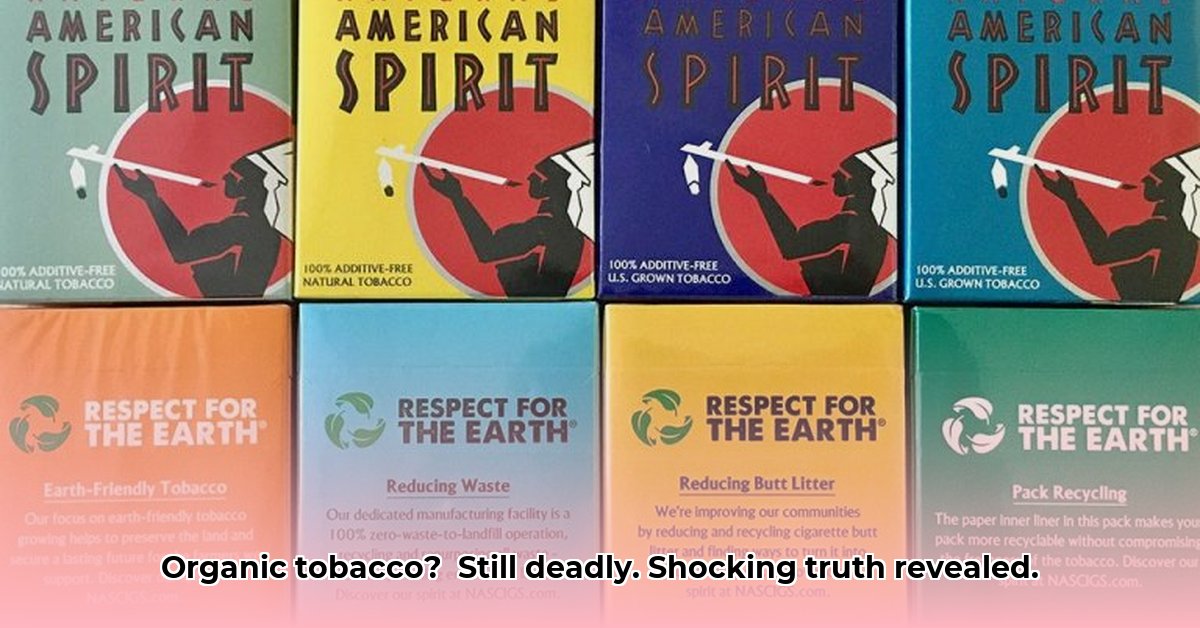Have you heard that organic tobacco is somehow healthier? It’s a common misconception, and a dangerous one. The truth is, whether it’s grown organically or not, tobacco is incredibly harmful. This article cuts through the marketing jargon and explains why. We’ll explore exactly what makes tobacco dangerous, no matter how it’s farmed, and debunk the idea that “organic” equals safer. We’ll look at the science, discuss misleading advertising, and offer resources to help you quit if you’re ready to ditch smoking for good. This isn’t about choosing between “better” tobaccos; it’s about understanding the risks and making healthy choices. For more information on natural tobacco, see this article.
Organic vs Regular Tobacco: The Shocking Truth
Let’s talk frankly about “organic” tobacco. The term itself sounds healthier, doesn’t it? Images of lush, pesticide-free fields probably spring to mind—a more natural, gentler way to enjoy a cigarette, right? But the reality, backed by solid scientific evidence, is significantly different. Choosing “organic” tobacco doesn’t make it any safer. In fact, the health risks remain just as substantial. What is the impact of misleading health information?
This isn’t some hidden conspiracy; it’s about the straightforward, undeniable facts. The main issue with comparing organic and regular tobacco often misses the key point: tobacco itself is inherently dangerous. No matter how it’s grown, tobacco contains nicotine—a highly addictive substance—plus several cancer-causing chemicals.
Decoding “Organic”: Understanding Farming Practices
When comparing organic and regular tobacco, the main difference boils down to farming practices. “Organic” tobacco is grown without synthetic pesticides and artificial fertilizers. That’s the extent of it. This doesn’t magically remove the nicotine or other harmful chemicals that are naturally part of the tobacco plant. Think of it like this: an organically grown apple is still an apple; it’s just been raised differently. The apple’s fundamental properties—like its sugar content—remain unchanged. Similarly, organic tobacco still has its nicotine and carcinogens.
The Nasty Chemicals: A Shared Problem
Burning any tobacco releases a toxic mix of substances. Nicotine is incredibly addictive, making it exceptionally hard to quit. Tar coats your lungs, causing significant damage to your airways and leading to breathing problems. Carbon monoxide reduces your blood’s ability to carry oxygen, impacting your entire body. And then there are the carcinogens—the cancer-causing substances—like formaldehyde and benzene, to name a few. These harmful chemicals are found in all tobacco products, regardless of whether they’re labeled “organic” or not. The comparison between organic and regular tobacco, in this aspect, reveals a striking similarity. They both pack the same punch when it comes to these harmful substances. How dangerous are carcinogens on the body?
| Substance | Harmful Effects | Found in Organic Tobacco? | Found in Conventional Tobacco? |
|---|---|---|---|
| Nicotine | Highly addictive; linked to heart disease | Yes | Yes |
| Tar | Damages lungs; contributes to respiratory illnesses | Yes | Yes |
| Carbon Monoxide | Reduces oxygen in the blood; affects many organs | Yes | Yes |
| Formaldehyde | Known carcinogen; causes various cancers | Yes | Yes |
| Benzene | Known carcinogen; associated with leukemia | Yes | Yes |
The Deceptive Marketing Game
The misleading marketing of “organic” tobacco is a significant concern. Companies use the term to create a false sense of security, suggesting that it’s somehow less harmful. This is a deceptive tactic that preys on vulnerable smokers who are already struggling with addiction. This deceptive marketing needs to be called out. We need clearer labeling and stronger regulations to counter this misinformation and ensure transparency in the tobacco industry. How do deceptive marketing tactics impact health? The comparison between organic and conventional tobacco should be based on proven scientific facts, not on clever marketing ploys designed to mislead consumers.
Understanding the Risks and Making Informed Choices
The bottom line is clear: all forms of tobacco are extremely dangerous. There aren’t any safer options. If you smoke, getting help to quit is crucial for your health and well-being. Many resources are available—counseling, medication, support groups—to help guide you through the quitting process. Your health—and your life—is worth the effort.
It’s crucial to remember that research on tobacco’s long-term effects is ongoing, and our understanding may continue to evolve. Some experts believe there could be subtle differences in the chemical makeup of organic and conventional tobacco due to cultivation methods, but the core message remains: all tobacco use carries severe health risks. What are some less known long-term effects of smoking? Don’t let clever marketing fool you. The harm is real, regardless of the label.
How to Identify Misleading Organic Tobacco Marketing Claims
Key Takeaways:
- Marketing “organic” tobacco as healthier is deceptive.
- All tobacco products contain harmful substances.
- “Organic” labeling doesn’t reduce health risks.
- Disclaimers often fail to counteract misleading claims.
- Consumers must critically evaluate marketing claims.
The Allure of “Organic”: A Deceptive Illusion
Let’s be honest: the idea of “organic” tobacco sounds healthier, right? It conjures up images of sun-drenched fields, natural growth, and a product somehow gentler on the body. But is this image accurate? The harsh reality is that this marketing tactic is a clever ploy, preying on our desires for something “natural” and implying a reduced risk. What is the power of psychological manipulation in marketing? But the truth is far more complicated.
What “Organic” Really Means (And Doesn’t)
The term “organic,” when applied to farming, refers to specific production methods that minimize synthetic pesticides and fertilizers. However, this doesn’t magically remove the inherent dangers of tobacco. Nicotine, tar, and countless carcinogens are naturally present in the tobacco plant, regardless of how it’s grown. Even “organic” tobacco contains these harmful substances. The process of curing and processing also introduces additional chemicals. How are the toxic compounds formed during tobacco curing?
The Hard Truth: Harmful Components Remain
Think of it like this: an organic apple might be pesticide-free, but it’s still an apple—with all its inherent properties. Similarly, “organic” tobacco remains tobacco, with all its harmful components intact. The crucial fact is that the health risks associated with smoking aren’t diminished by organic farming practices. Scientific studies consistently demonstrate equivalent harm from both organically grown and conventionally grown tobacco.
Deceptive Marketing Tactics: Spotting the Red Flags
How to Identify Misleading Organic Tobacco Marketing Claims:
- Scrutinize labels carefully: Look beyond buzzwords like “organic,” “natural,” or “additive-free.” What specific claims are being made? Are they backed by scientific evidence?
- Be wary of vague statements: Marketing often uses ambiguous phrases to create an impression of safety without providing concrete proof. Demand clear, evidence-based statements.
- Recognize the lack of health benefits: Any tobacco product, whether labeled “organic” or not, significantly increases your risk of cancer, heart disease, and respiratory illness. There’s no such thing as a “safe” cigarette.
- Question implied health benefits: If a claim suggests reduced harm, ask for the scientific evidence supporting it. Often, you won’t find any.
- Consider the source: Is the information coming from a credible, independent source, or from a tobacco company with a vested interest in selling its products? What are the strategies to verify independent scientific resources?
The Role of Regulation and Consumer Awareness
Studies consistently show that disclaimers often fail to correct the false impression of reduced harm linked to organic claims. Stronger regulatory oversight is necessary, with complete bans on using terms implying reduced risk. Along with regulation, public health campaigns play a crucial role in educating consumers about the deceptive nature of these marketing tactics.
Ultimately, the only truly safe choice is to avoid tobacco altogether. If you’re a smoker, seeking help to quit is the most important step you can take for your health. Many resources are available to support you on this journey.
[This article synthesizes information from multiple studies, including those cited in the provided context. For in-depth research, refer to relevant sources mentioned in the context.]
Proven Tactics to Quit Smoking- Regardless of Tobacco Type
Key Takeaways:
- The belief that organic tobacco is safer is a myth. All tobacco products are incredibly harmful.
- “Organic” simply means the tobacco was grown without certain synthetic pesticides. It doesn’t change the addictive nicotine or cancer-causing compounds.
- Effective smoking cessation methods, including CBT and NRT, work regardless of tobacco type.
- Quitting is challenging but achievable with support and proven strategies.
The “Organic” Tobacco Illusion
Let’s address the elephant in the room: Many believe “organic” tobacco is a healthier choice. Is it true? Absolutely not. Organic certification focuses on farming practices, not the inherent dangers of the plant itself. Think of it like this: an organic apple is still an apple. Its nutritional value might be slightly different, but it’s still fruit. Similarly, organic tobacco remains incredibly harmful. The nicotine addiction is the same; the carcinogens are still there. Is there a minimum safe amount of tobacco use?
What exactly does “organic” certification mean? It
- Lunch Box That Fits Bento Box Neatly for Daily Use - December 5, 2025
- Japanese Lunch Bag Does Double Duty as Bento Carrier and Tote - December 4, 2025
- Your Perfect Bento Box Bag For Fresh And Tidy Meals - December 2, 2025










